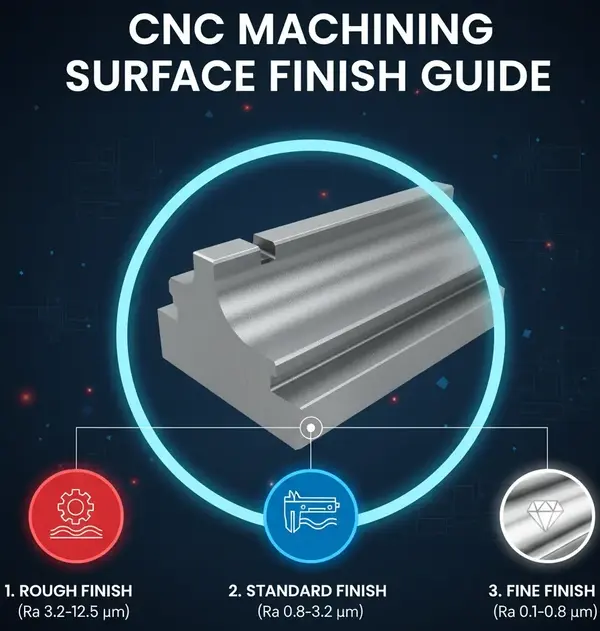
CNC machining surface finish is a process that artificially creates a surface layer with varying properties on the base material. It is a critical manufacturing step. Untreated parts can suffer from burrs and roughness. Treatment can repair these defects and improve corrosion resistance, strength, and aesthetics, meeting the stringent requirements of the automotive, aerospace, and other industries. It is a key means of increasing product added value and competitiveness.
Core Value: Resolving surface defects after CNC machining, enhancing corrosion resistance, wear resistance, and other properties, and improving aesthetics to meet the needs of multiple industries.
The Necessity and Core Value of CNC machining surface finish
Surface finish of CNC parts is a key step in improving part performance. Its necessity is reflected in 3 key dimensions: functional optimization, safety and compliance, and aesthetic enhancement. In terms of functional optimization, the fatigue life of untreated aircraft engine blades is reduced by 40%. Anodizing creates a 5–20μm oxide layer with salt spray resistance of 500 hours, meeting MIL-A-8625 standards. When the surface roughness of medical devices exceeds Ra 0.8μm, the risk of bacterial growth increases threefold, requiring treatment to control it to Ra ≤ 0.4μm to meet ISO 10993 biocompatibility requirements.
In terms of safety and compliance, burrs can cause assembly jams, and medical component burrs must be kept below 0.02mm, meeting ISO 13715 standards. Cleaning to remove oil and impurities can extend the rusting time of precision cold-drawn tubes in an 80% humidity environment from 72 hours to over 1,000 hours.
Aesthetic enhancements include powder coating, which achieves a colorful appearance and improves weather resistance by 2.5 times. The vacuum plating process ensures that 80% of the coating remains after 5,000 abrasions, significantly reducing after-sales maintenance costs.
Core Value Data
- Corrosion Resistance: Anodizing withstands 500 hours of salt spray testing, while vacuum plating withstands over 96 hours of salt spray testing.
- Safety: Deburring reduces assembly defects from 5% to 0.3% and reduces bacterial adsorption on medical components by 80%.
- Cost-Effectiveness: Surface finish can extend mold life by 3-5 times and reduce overall maintenance costs by 40%.
Surface finish, through the synergistic effect of physical strengthening and chemical modification, imparts wear resistance, corrosion resistance, and easy cleaning properties to CNC parts.
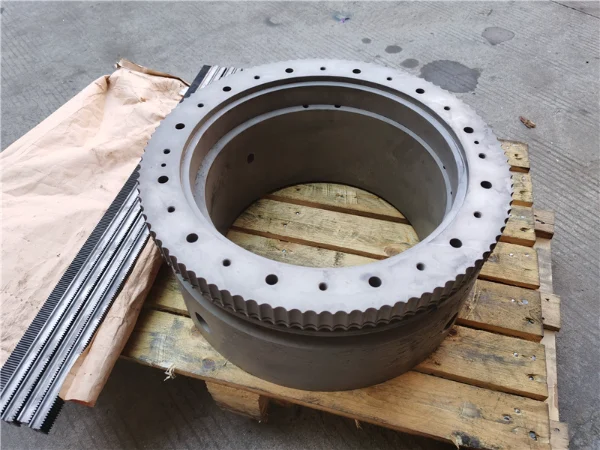
For example, the hardness of electroless nickel plating reaches 400-700 HV, which can be increased to 1000 HV after heat finish, increasing wear resistance by three times compared to untreated parts. Plasma cleaning technology increases surface energy from 30 mN/m to 72 mN/m, improving coating adhesion by over 50%. These performance improvements enhance product reliability. For example, the pass rate for high and low temperature resistance tests for automotive electronic components increased from 82% to 97% after plasma treatment, fully demonstrating the irreplaceable role of surface finish in high-end manufacturing.
Detailed Explanation of 10 CNC machining Surface finishes Processes
Surface finish of CNC parts is a critical step in improving product performance and aesthetics. The following details the core parameters and application scenarios of 10 mainstream processes:
Anodizing
- Principle: Electrolytic formation of an Al₂O₃ film, categorized as either standard (5-25μm) or hard (25-150μm)
- Parameters: Voltage 10-20V, Temperature 15-25°C, Treatment Time 15-60 minutes
- Applications: Aluminum alloy casings (such as mobile phone midframes), with a salt spray resistance test exceeding 500 hours
Electroplating
- Principle: Electrolytic deposition of a metal layer (chrome/nickel/zinc)
- Parameters: Coating thickness 0.2-50μm, Current density 1-5A/dm²
- Applications: Hard chrome plating (HV900 hardness) on mold inserts, wear resistance for automotive parts
Sandblasting
- Principle: Sand blasting (glass beads/aluminum oxide) creates a matte surface
- Parameters: Pressure 0.3-0.6 MPa, grit size 60-240
- Application: Pretreatment before anodizing, eliminating tool marks
Polishing
- Principle: Mechanical/chemical reduction of surface roughness
- Parameters: Ra up to 0.008 μm (mirror finish), treatment time 30-120 minutes
- Application: Mirror polishing of stainless steel medical devices
Chemical Deburring
- Principle: Chemical solution dissolves burrs
- Parameters: Temperature 50-80°C, treatment time 5-20 minutes
- Application: Parts with complex internal cavities (e.g., hydraulic valve blocks)
Powder Coating
- Principle: Electrostatically adsorbed powder coating, curing at 200°C
- Parameters: Coating thickness 60-120 μm, adhesion grade 0
- Application: Weather-resistant coating of appliance housings
Laser Engraving
- Principle: Laser burning creates permanent markings
- Parameters: Power 20-50W, Engraving Depth 0.05-0.3mm
- Application: QR Code/Logo Marking on Accessories
Chemical Nickel Plating
- Principle: Electroless deposition of a Ni-P alloy layer
- Parameters: Coating thickness 5-20μm, Hardness HV 500-1000
- Application: Surface hardening of mold steel
Passivation
- Principle: Formation of a Cr₂O₃ passivation film on the stainless steel surface
- Parameters: Processing time 10-30 minutes, Salt spray test >500 hours
- Application: Food-grade stainless steel accessories
Wire Cutting (Wire EDM) Texturing
- Principle: Electric spark discharge erodes the metal surface
- Parameters: Surface roughness Ra 1.4-1.7μm, Accuracy ±0.003mm
- Application: Texture processing of mold cavities
Process parameter comparison table
| Processing | Processing time | Cost range(USD) | Film thickness(Ra) |
| Anodizing | 30-60min | 1.5-5 | 5-25μm |
| Electroplating | 20-40min | 2-8 | 0.5-50μm |
| Sandblasting | 5-15min | 0.8-2 | 1.6-3.2μm |
| Powder Coating | 30-45min | 1-3 | 60-120μm |
CNC Parts Surface finishes Selection Principles:
- Function Priority: For wear resistance, choose electroplating/electroless nickel plating; for corrosion resistance, choose anodizing/passivation.
- Precision Matching: For a mirror finish, a combination of polishing and grinding is required.
- Cost Control: For mass-produced parts, sandblasting/powder coating is preferred; for precision parts, laser engraving is used.
CNC machining Surface finish solutions for metal and plastic parts
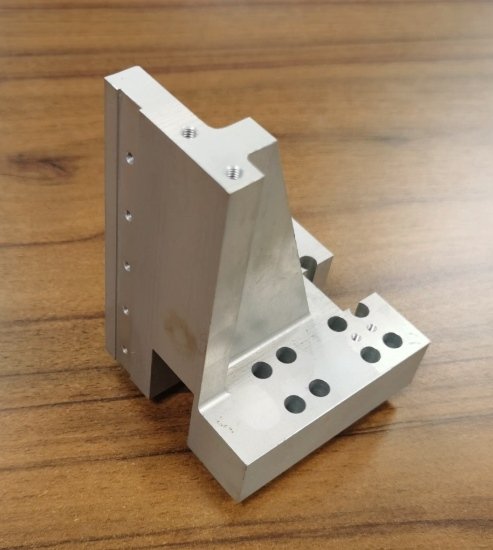
CNC machining Surface finish solutions for metal parts
| Material Type | Recommended Process | Application Scenarios | Core Advantages |
| 6061 Aluminum Alloy | CNC milling + anodizing | Electronic housings, mechanical structural parts | Improved corrosion resistance, with a surface hardness exceeding HV300. |
| 7075 Aluminum Alloy | Hard anodizing | Aerospace load-bearing components | Wear resistance tripled, with a salt spray test exceeding 500 hours. |
| 304 Stainless Steel | Electrolytic polishing | Medical devices, food contact parts | Surface finish Ra ≤ 0.8μm, offering excellent corrosion resistance. |
| Brass C36000 | Nickel plating | Connectors, conductive components | Improved electrical conductivity and enhanced oxidation resistance. |
Metal surface finish to improve corrosion resistance and mechanical properties.
For example, anodizing aluminum alloys creates an oxide film with a thickness of 5-20μm. After treatment, 6061-T6 aluminum alloy can achieve a hardness exceeding HV300, making it suitable for applications requiring high wear resistance, such as electronic device casings. Electrolytic polishing or PVD coating of stainless steel not only meets medical-grade cleanliness requirements but also improves wear resistance by over 30% through surface modification.
CNC machining Surface finish solutions for plastic parts
| Material Type | Recommended Process | Application Scenarios | Core Advantages |
| ABS/PC | Vacuum plating (primer + evaporation) | Electronic housings, home appliance parts | Coating adhesion reaches 5B grade, resulting in an excellent mirror finish. |
| PP | Plasma surface finish | Automotive parts, medical products | Surface energy increased from 30mN/m to 72mN/m. |
| POM | Matt finish | Precision gears, bushings | Coefficient of friction reduced to 0.08, improving fatigue resistance. |
| PA66 | Laser etching + spray coating | Mechanical components, connectors | Coating adhesion increased by 40%, enhancing weather resistance. |
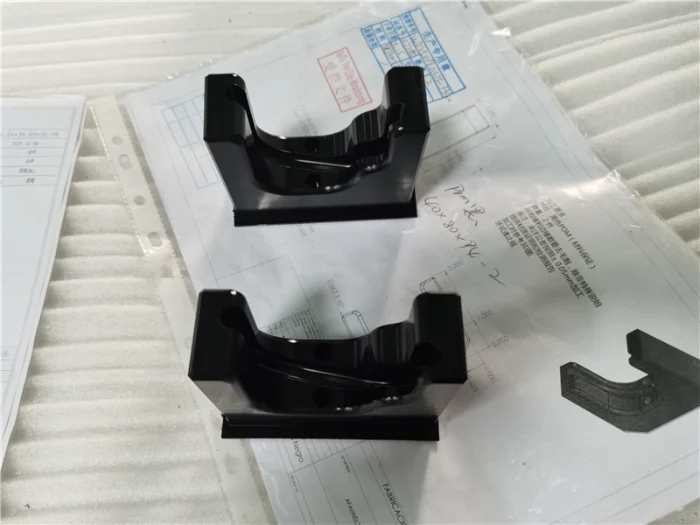
Plastic surface finish focuses more on interfacial adhesion and functional modification. After plasma treatment, the surface energy of polypropylene (PP) increases from 30mN/m to 72mN/m, meeting the adhesion requirements of electrophoretic paint for automotive parts. ABS material can achieve a metallic-textured coating through a “primer + vacuum plating” process, with a coating thickness of 0.8-1.2μm, suitable for consumer electronic housings. For specialty plastics like PEEK, matte treatment can reduce surface reflectivity to below 15%, meeting the optical requirements of medical devices.
Key differences: Metal treatment focuses on creating a protective layer through oxidation and electroplating. For example, anodized aluminum alloy films offer salt spray resistance of up to 500 hours. Plastic treatment addresses interfacial compatibility through plasma activation and primer pretreatment. After treatment, PP material can achieve 5B adhesion on the 100-grid test. Both require a process selection based on material characteristics: metals prioritize electrochemical stability, while plastics focus on surface energy control.
Cost and time comparison of CNC machining surface finish
Comparison table of metal material surface finish cost and time
| Process Type | Cost (USD/m²) | Processing Time(Minute) | Applicable batch | Cost sensitivity to batch size |
| Sandblasting | 1-3 | 5-15 | Full batch | No significant change |
| Anodizing (normal) | 2-5 | 30-60 | Medium to large batch | Large-volume unit price reduction of 40% |
| Hard anodizing | 3-6 | 60-90 | Medium batch | Large-volume unit price reduction of 35% |
| Electroplating (chrome plating) | 3 usd/kg | 8-15 | Large batch | Cost reduction of 25% for batch sizes >1,000 pieces |
| Plasma polishing | 0.1 usd/piece (consumables) | 3-5 | Large batch | Recovery achieved for batch sizes >5,000 pieces |
Comparison table of plastic material CNC machining surface finish cost and time
| Process Type | Cost (USD/m²) | Processing Time | Applicable batch | Cost and Batch Sensitivity |
| Vacuum Plating | Medium | 1-3 days | Medium batch | Batch sizes > 5,000 pieces: 30% cost reduction |
| Powder Coating | 1-3 | 30 minutes | Large batch | Batch sizes > 1,000 pieces: 20% unit price reduction |
| Plasma Treatment | <0.03 | 1-3 minutes | Full batch | Equipment investment payback within 8-10 months |
The core impact of batch size on cost: Taking electroplating as an example, when batch size increases from 100 to 1,000 pieces, unit costs can be reduced by 40%, primarily due to increased equipment utilization and the sharing of labor costs. A new energy vehicle parts manufacturer reduced the unit cost of anodizing from 4 USD per square meter to 3 USD per square meter by optimizing batch sizes, resulting in annual cost savings exceeding 4.5w usd.
In terms of cost control strategies, mold polishing instead of sandblasting can reduce post-processing steps. One automotive mold manufacturer adopted high-gloss mirror polishing (Ra ≤ 0.05μm), eliminating the sandblasting step and reducing unit costs by 18%, but incurring a 30%-50% increase in mold polishing costs. Plasma polishing reduces energy consumption by 70% and increases processing speed by 10 times compared to traditional electrolytic polishing, making it particularly suitable for large-scale stainless steel processing.
In terms of time optimization, stainless steel surface finish proofing cycle time is only 1-3 days, and processing cycle time is 4-7 days, while processes such as titanium plating and chrome plating require 8-15 days. A communications parts manufacturer used the Dacromet process to reduce the surface finish cycle for public telephone covers from 7 days to 1-3 days, meeting rapid delivery requirements.
Overall, companies need to select the optimal process based on material properties, batch size, and delivery cycle, balancing cost and efficiency. For example, plasma polishing is preferred for small batches of high-precision parts, while anodizing or electroplating is suitable for large batches of metal parts. For plastic parts, vacuum plating can be considered to shorten cycle times.
Conclusion: Technological Trends and Selection Recommendations for CNC machining surface finish
The core of CNC part surface finish lies in balancing functionality and cost-effectiveness through process optimization. Its technological evolution is driven by both environmental protection and intelligent technology. Future trends focus on green processes such as nano-coating (for example, AlTiN PVD coating increases tool life by 2 times) and plasma oxidation (reducing energy consumption by 75%), as well as the in-depth integration of intelligent control technologies such as AI parameter optimization and digital twins.
When selecting a product, a three-dimensional evaluation system based on “environment-performance-cost” should be established: Fluorocarbon spraying (resistance to Cl⁻ corrosion) is preferred for extreme environments; hard anodizing (hardness > 300 HV) is selected for high-wear applications; and powder coating (reducing costs by 40%) can be used for budget-sensitive interior parts.
Companies should proactively develop low-VOC processes such as chromium-free passivation and vacuum plating to address evolving environmental regulations. Furthermore, they should ensure process stability through test cutting verification (such as a 48-hour salt spray test), ultimately aligning technological iteration with commercial value.
Core Principle: Surface finish should be based on material properties (e.g., aluminum is suitable for anodizing) and application-specific requirements (e.g., medical components prioritize antibacterial properties). While meeting core performance indicators such as corrosion and wear resistance, a combination of processes (e.g., sandblasting + anodizing) should be used to achieve the optimal balance between performance and cost.
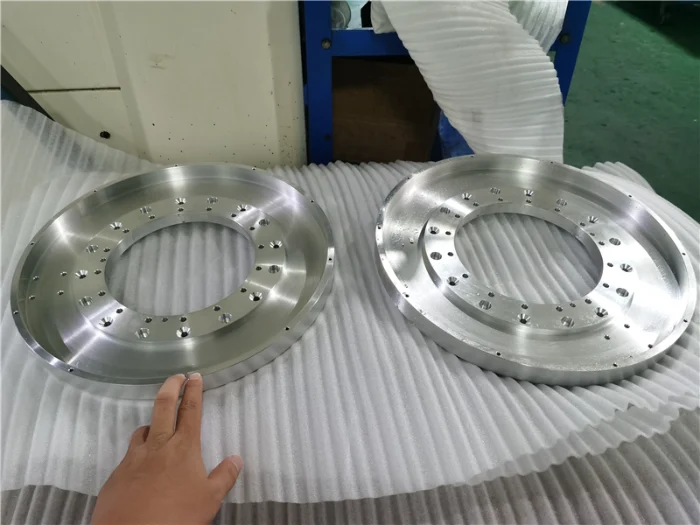
Conclusion for this article
This article comprehensively analyzes the necessity, core value, mainstream processes, metal and plastic adaptation solutions, and cost and time comparison of CNC surface treatment, and proposes technical trends and selection suggestions. If you have other questions or want to find an experienced CNC processing service provider, you can contact us WELDO to get the latest information and quotes.
FAQ of cnc machining surface finish
What is the surface finish of CNC machining?
Surface finish refers to the microscopic geometric features of the workpiece surface after CNC machining, typically quantified by surface roughness (parameters such as Ra and Rz). The smaller the Ra value, the smoother the surface. For example, a Ra of 0.8μm is finer than a Ra of 3.2μm. Surface finish directly affects a part’s wear resistance, corrosion resistance, sealing, and appearance.
What factors affect the surface finish of CNC machining?
The main factors include:
Tool condition: Worn tools will leave scratches and require regular replacement or resharpening.
Cutting parameters: Improper feed rate, depth of cut, and spindle speed can cause chatter marks or burns.
Material properties: Soft metals (such as aluminum) are prone to tool sticking, while hard metals (such as steel) may crack.
Machine tool rigidity: High vibration on a machine tool can reduce surface quality.
Coolant: Insufficient lubrication can cause cutting heat to accumulate, affecting surface finish.
How can I optimize surface finish through cutting parameters?
The following parameters can be adjusted:
Reducing the feed rate: Reduce the feed per revolution (e.g., from 0.1mm/rev to 0.05mm/rev), but balance this with efficiency.
Reducing the depth of cut: For finishing, a depth of cut of 0.5mm or less is recommended to avoid excessive cutting forces.
Increasing the spindle speed: High-speed cutting (e.g., above 10,000 RPM) can reduce built-up edge, but tool life must be considered.
Using climb milling: Climb milling produces better surface quality than conventional milling.
How does tool selection affect CNC machining surface finish?
Tool material, coating, and geometry are key:
Material: Carbide tools are suitable for high-speed machining, while ceramic tools are suitable for hard materials.
Coating: TiN (titanium nitride) coatings reduce friction, while TiAlN (titanium aluminum nitride) coatings offer high-temperature resistance. Geometry: Tools with large rake angles cut lightly but lack rigidity; tools with small rake angles are suitable for heavy cutting.
Edge Preparation: A sharp edge (such as a 0.1mm chamfer) can reduce burrs, but regular resharpening is required.
How can I remedy substandard surface finish after CNC machining?
The following measures can be taken:
Hand polishing: Manual polishing using sandpaper, oilstone, or polishing paste is suitable for small repairs.
Vibratory grinding: The workpiece and abrasive are placed in a vibrating container to remove burrs in batches.
Chemical polishing: Surface protrusions are dissolved through pickling or electrolyte treatment. Suitable for materials such as stainless steel.
Refining: If deformation is severe, remachining is required with reduced cutting parameters.
